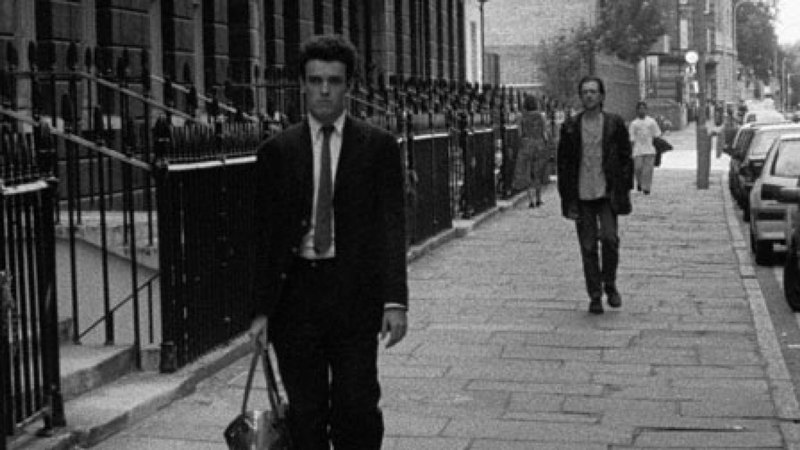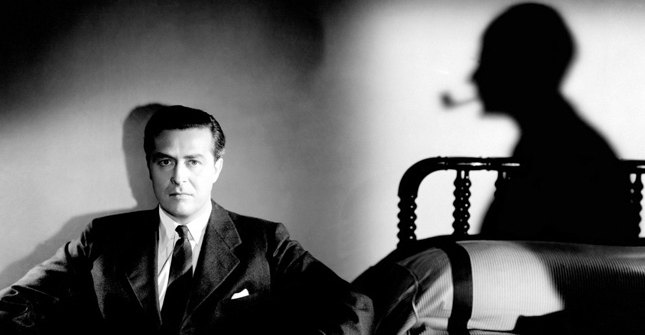Even in the scenes where he screams and shouts as he transforms from the human stunt biker Johnny Blaze into a creature with a flaming skull known as Ghost Rider, Nicolas Cage looks like he’s having one hell of a good time. It’s been years since Cage threw himself into a role with such playful abandon. Co-star Eva Mendes, meanwhile, just threw herself into it without even seeing a script. And somehow, under the guidance of Mark Steven Johnson, it all comes together in a respectable adaptation of the Marvel comic book.
American blues legend Robert Johnson wrote a song (“Crossroad Blues”) about going down to the crossroads to make a deal with the devil. He’d trade the devil his soul in exchange for an extraordinary ability to play the guitar. According to legend, it was the devil who took Robert Johnson from this life at the young age of 27, before the musician had a chance to savor his success. Johnson died after drinking from an open whiskey bottle at a road house, the most likely explanation that he was poisoned by the angry husband of a woman he had known before and was trying to romance again.
That crossroads legend (minus the angry husband) is at the core of “Ghost Rider,” which finds young stunt rider Blaze (played by Matt long) doing stunt-bike shows with his father (Brett Cullen). He’s about to run off with childhood sweetheart Roxanne Simpson (Raquel Alessi) when he learns that his father has a nasty cancer that’s going to kill him. And so he makes a deal with the devil to cure his father. The thing is, as with the Robert Johnson legend, it’s awfully hard to outsmart the devil. Mephistopheles (Peter Fonda) can get around pact-language quicker than you can say “Huh?” He agreed to heal Dad, but he didn’t say anything about protecting him from fatal motorcycle crashes.
Years pass and the adult Johnny Blaze (Cage) is now a fearless stunt rider of considerable fame, while the childhood sweetheart (Mendez) he stood up is now a TV news reporter assigned to interview him. But the real action begins when Mephistopheles claims Blaze’s soul and gives him the job of Ghost Rider, a flaming motorcyclist whose job it is to round up the rotten souls who should be in hell. His big challenge? Round up Blackheart (Wes Bentley), the disobedient (hey, fruit doesn’t fall far from the tree) son of Satan who decided that he wants to make hell on earth. With his buddies, all of them wearing long coats and looking like bad guys in Westerns, he stalks the earth looking for trouble. When Blaze is Ghost Rider he’s ready to oblige. But when he’s plain old Johnny Blaze, his goal is to get to a cemetery where hopes to find the secret of Carter Slade, the legendary first Ghost Rider who gathered up all of Satan’s bad-souls but then refused to hand them over. Somehow, he figured how to outsmart Mephistopheles, and Blaze is desperate to learn the secret so he can do the same.
It’s a pretty straightforward narrative that probably devotes more time to the skull-head than it should, considering Cage is so much fun to watch. And while there are obvious homages being paid to “Easy Rider” (the bike Ghost Rider uses is a jazzed-up copy of the Captain America bike that Fonda rode in that counter-culture film), Fonda is about as bland a Satan as I’ve seen on film. And his cinematic son isn’t much better. Bentley makes Blackheart seem more like one of the jaded twentysomethings that turn up in bad teen films than a truly menacing villain. But there’s enough black humor here to make up for a lot of sins. During the big battle between Blackheart and Ghost Rider, for example, the evil one conjures up a semi-trailer to plow over the flaming skull. A quick cutaway shows the sign on the back of the truck, which reads, “How’s my driving?” So there’s a tone here that’s appropriate to the comic-book treatment. Another big plus? The special effects, specifically the CGI fire, which looks as real to my eyes as the real thing we saw in “Ladder 49.” On one of the documentaries we learn that Image Works actually rewrote a new program to crank it up a notch when it was apparent that current technology wasn’t sufficient to make the fire look realistic.
And then there’s Sam. Whether he’s playing the sagely bouncer in “Road House” or a cemetery caretaker, as he does here, Sam Elliott has such a unique presence that he elevates the film when he’s onscreen. More than Mendez, he seems to connect with Cage, and maybe it’s a shared love of bikes that’s responsible. Cage said that this film was partly about trying to get people excited about motorcycles again. That’s evident at least with Cage, who hasn’t had this much fun around bikes since “Raising Arizona.”
The “extended cut” inserts mostly quieter scenes that flesh out the story a little, so that it has more emotional resonance. It’s an improvement over the theatrical release. What film about Satan and hell couldn’t use more depth?
Video:
The 1080p Hi-Def picture is presented in 2.40:1 aspect ratio, and it’s fairly stunning, especially with those fiery sequences. Some of the darker scenes get a little murky, but that seems to have been a director’s choice. Colors are generally bright and fully saturated, and the level of detail is very, very good.
Audio:
It’s no secret that I’m a fan of PCM, and this English 5.1 uncompressed soundtrack is pretty phenomenal. You’d hope for that, actually, with so many choppers roaring around and flames sizzling. The sound is so pure and clean that it fills the room. An English Dolby TrueHD soundtrack is also pretty good, but the French 5.1 sounds a little flat by comparison.
Extras:
Two commentaries are included, one by writer-director Mark Steven Johnson and visual effects supervisor Kevin Mack, and the other by producer Gary Foster. Normally it’s the director’s track that’s most worth listening to, but this time Foster’s commentary was the biggest surprise. If you ever want to know what a producer does, you get a pretty good idea here, as Foster tells stories about “fires” he had to put out. By comparison, Johnson and Mack’s commentary is pretty standard, and they spend an awful lot of time telling us how wonderful the whole experience was for them.
Three roughly 20-minute documentaries are also included, though the divisions seem strange: spirit of vengeance, spirit of adventure, spirit of execution. Mostly we’re talking about a single making-of feature that’s been cut into three segments highlighting conception and pre-production, production, and post-production. But even then there’s overlapping, with plenty of behind-the-scenes production shots. Sometimes there’s a split screen showing two separate sequences with a voiceover, and I found that to be the most concentrated and interesting way to get a feel for the process. The pace was leisurely, and there was plenty of raw footage to satisfy movie-lovers. As behind-the-scenes features run, these were pretty good.
Missing from the extended cut DVD is a roughly 50-minute overview of the comic book, “Sin & Salvation,” so fans will still have to hang on to their non-HD copies. If studios don’t rectify this problem soon, none of us are going to have space for anything.
Bottom Line:
The extended cut puts a little meat on the bones of this skeleton tale, and Blu-ray makes those wonderful CGI flames look even better. “Ghost Rider” might not be the knock-your-socks-off comic book adaptation that fans were hoping for, but it’s solid enough.


